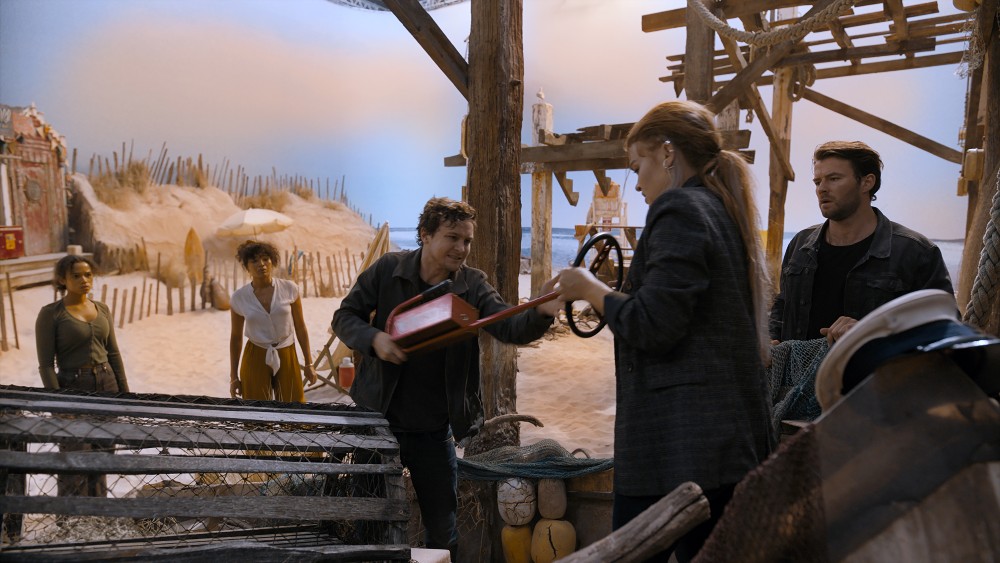
Tournament of Champions continues the story from the original movie with Zoey and Ben, the characters played by Taylor Russell and Logan Miller, travelling to New York to find the Minos Corporation and being pulled back into their deadly games, along with a new group of players who survived previous escape rooms. Their new adventure begins in a New York City subway car that isn’t what it seems, and the rooms just get deadlier and harder to solve as they go along.
Last week, Below the Line spoke with Production Designer Edward Thomas, about what went into designing both films, but more importantly, building and making these rooms functional, an amazing combination of practical set locations and visual effects. (Note: There are some minor SPOILERS about Escape Room: Tournament of Champions in terms of the mechanics of the escape rooms in the movie, which may be best enjoyed before knowing how they were done.)
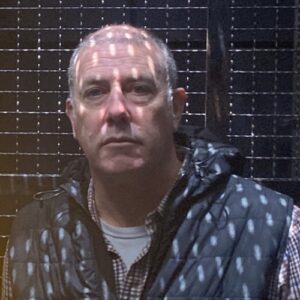
Below the Line: I knew even before I saw the movie that I wanted to talk to you. Even the negative reviews of the movie mention your production design, so I’ll take that as a victory as someone who covers below-the-line, to hear critics even mentioning production design.
Edward Thomas: Thanks for your kind words, and singling me out in the review you did. The design of these particular movies is such a strong part of it, that it’s great even if it gets mentioned, but it’s what’s scripted at the end of the day, and we deliver what’s scripted, but it is definitely a character in the movies.
BTL: I wasn’t aware of your background before sitting down to talk to you, but in my research I discovered that you production designed the first few seasons of the Doctor Who show, and those shows always look amazing with so many locations. Going back a bit, what was your background that got you into production design in the first place?
Thomas: I was very fortunate to join a youth theatre, where I lived in Swansea in deepest, darkest Wales. There was a youth theatre that I joined when I was about 16, 17, which was at a community based youth theatre where they’d have residential courses, and they’d put on a summer course and a winter course. There was quite a very good cohort of people who had come out of that — Russell T. Davies, who wrote Doctor Who, Michael Sheen, the actor. We were all sort of in it together as kids. Through that youth theatre, I met a mentor of mine, Sean Crowley, who was a designer, and he said, if you want to do theater design, you should go to Wimbledon School of Art, which was one of the only four colleges at the time when I was young back in the 80s, that did theater design. And so I did. He shone a light on that part for me, and off I went. I was lucky enough to get into. I came out and sort of started in theater, but it didn’t really appeal to me as much as I thought it would. I slowly started drifting into advertising, into commercials, art directing for postable commercials, initially, which were quite big sets back in the 90s, there was a lot of sort of poster board commercials happening for car manufacturers and stuff. And they were big builds — you’d build the entire streets of a French Provence street, because they had a lot of money in those days.
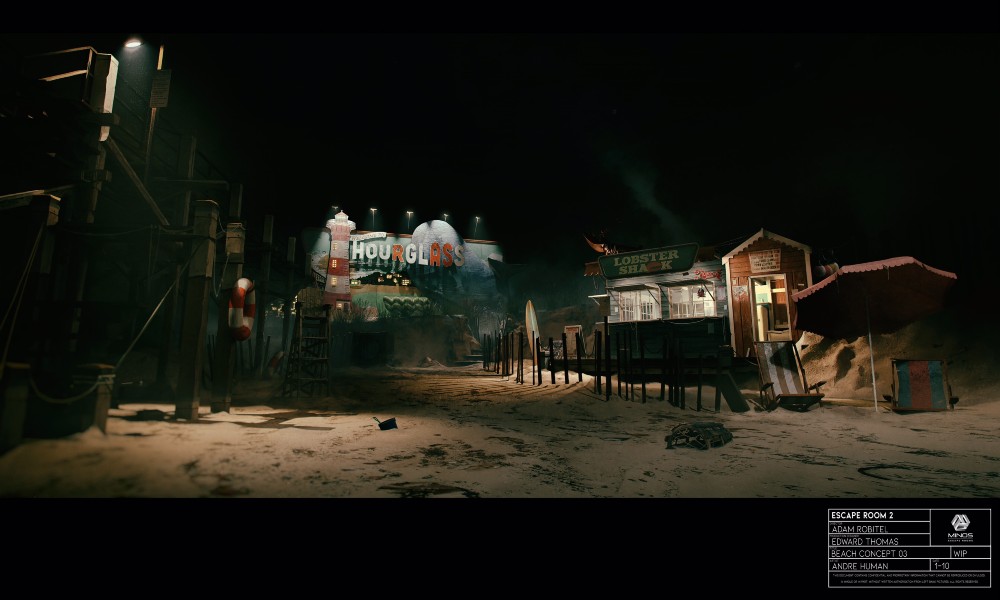
And then from that, I sort of drifted into commercials, and then from commercials, I got my first feature film, which was a very low budget, period feature film that we shot in the UK in the summer of ’92. I think it was the only funded British feature film in the summer of ’92, and everybody wanted to be in it. Judi Dench, all those guys. It was called The Mystery of Edwin Drood, and as soon as I did that, I got the bug. I worked with a really lovely DoP, Martin McGrath, an Australian DoP, who was very generous, because I’d never been on a film set my entire life. But that was it, I got the bug, and from there, I just chased the dream and went from one thing to another.
I ended up in South Africa, in Johannesburg, for a long time — I did six years down there, and I really cut my teeth on movies. We did everything from vikings to sci-fi to fantasy, all these different movies from these different companies and Joburg was a great palette to work with. And then I came home one weekend to see my Mum and Dad, and I saw in the newspaper, Doctor Who. I remember as a child being scared of it. I don’t remember being particularly into it, but because I had gone on this fantasy journey with my work, I just thought this is going to be great. I actually went to meet Russell and Julie Gardner, another West Melbourne Youth Theater alumni, and we sort of rekindled our relationship and that was it. Doctor Who’s five seasons led into a show called Torchwood, Torchwood led into a show called Sarah Jane Adventures. That led to another show called Sherlock, which was quite a successful TV show that I did. And then, I had run the remit of the BBC, I’d sort of done as much as I felt I could do there. I thought I would look for pastures new, and I wanted to keep in the sci-fi vein. I did another show called Outcasts, which we shot in South Africa. And then through Outcasts, there was a lovely director Bharat Nalluri, who was great friends with Paul Anderson, and he told me about Paul and how wonderful his movies were. Of course, I had referenced all the Resident Evil movies in my work. Next thing I know, I got a call from Paul, just totally out of the blue, saying, “We’re going to do Resident Evil. It’s gonna be the final chapter,” and that, for me, was like the icing on the cake. Back in South Africa I was. We did that, and then Paul asked me to go on to his next series called Origin, which was for YouTube. I just completed Monster Hunter with him, which has just come out in cinema. In between those movies, this director called Adam Robitel, again, came out of the blue, and just said, “Hi, I’m Adam. This is what I’ve done, this is what we’re doing, and I’ve got this film and the sets are going to be part of it, and it was called Escape Room.” I jumped at the chance, because anything where the sets are actually driving the story in the way they do with the Escape Room is phenomenal.
The first one was challenging, we had $10 million dollars — it wasn’t a huge budget. We were blessed to be shooting in South Africa with fantastic crews, fantastic technicians who do all these things iasa challenge. Obviously, it did very well, and Adam was presented with options to do a sequel with a bit more money to throw at it, and I think that shows on the screen, potentially. We went back to Africa, made the right decision, reengaged all the technicians we had on the first movie, so it felt like a real family affair. Rekindled the relationship with Mark Spicer, the amazing DoP that Adam’s been using. We really worked through these sets together from a visual DoP point of view, for a production designer, it’s a really important relationship.
BTL: So you’ve been working in South Africa for the last few years then? You’re still there?
Thomas: No, my work seems to go in cycles. So I ended up working in Johannesburg for about six years, then I went back to Wales and ended up working for BBC Wales, and other companies for another six years.Then all of a sudden, I was back in South Africa for another six years, doing the Resident Evil, Origin and Monster Hunter, and now I’m finding myself in Malta, doing a film for Amblin, Mr. Spielberg. It’s called the Last Voyage of the Demeter. Really, really lovely director who is very similar to Adam, actually, Andre Ovredal, who did the Autopsy of Jane Doe.
BTL: I’ve interviewed him a few times over the years.
Thomas: What a gentleman, and what a visionary when it comes to the horror genre, so I’ve just been blessed to work with top, top directors, whether they’re at the start of their career, but gentleman, absolute gentleman.
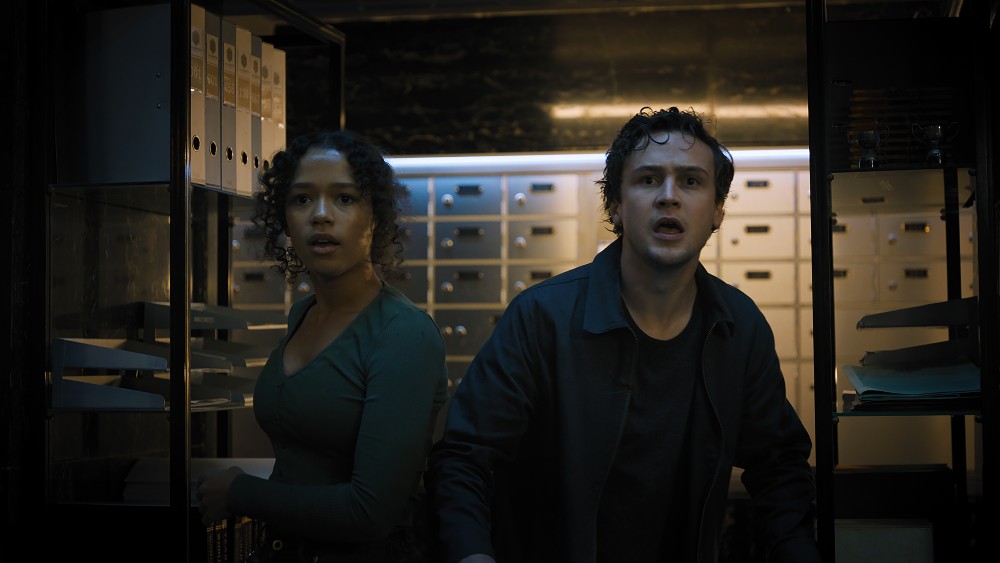
BTL: Let’s get into Escape Room. Obviously, you’re involved very early on in projects, so for the sequel, were you able to get involved even earlier in the script stage, so the writers would know what was physically possible in terms of the puzzles, and what can be done as physical sets?
Thomas: I think we learned so much on the first one that gave us a huge benefit going into the second one. I was engaged very early on in the second one, probably earlier than on the first one for that very reason. What are we best at? What are the crews in South Africa best at creating? What are the locations that we can get there? We had a good budget, but it’s not an endless budget, and there are ideas the writers had, like the subway station — you’re never going to find that as a location in South Africa, so you’ve got to build that. In order to then inject some real production value and scale to it, what locations can we find in South Africa that can really give the film a really massive look. Of course, the bank was the perfect case and point for that, because an old bank that has been closed for many years, it presented itself beautifully. We went through lots of those scenarios where there were long tunnels, there were old factories, banks, nightclubs… there were all sorts of different locations that we fed into the writing. And, of course, the killing methodology is very important to these rooms, so it’s about a balance of trying to mix killing methodologies, clues, and how to drive the story along. It’s a real melting pot, that you’re throwing all these ideas in. Some of them are wonderful ideas, but they don’t work with the story, and that saddens me sometimes, because some of the rooms were designed that will never see the light of day.
So very early on with the writers, back and forth, location photographs, obviously, early concept work. I’ve got a great concept artist named Andre Human, who helps me with bringing these images to life. And then working through the puzzles, and on how best to, to achieve them. Of course, they’re as complicated as designing the rooms. As you can imagine, there’s a huge amount of engineering that goes into these rooms, with trying to drown people in sand, all the sort of the automation that goes with that underneath the sand and how high you have to build sets to be able to get rid of that sand as heavy as sand is. And then in the end room with the water, the amount of water and how quickly it comes out of that space when that glass smashes. Where does all that water go when it enters the room. If I can send you some images of the sets from outside, I think you’d be quite amazed.

BTL: Were you able to get old used NYC subway cars or did you have to build those from scratch?
Thomas: We had to build it from scratch. It had to do so many things that we wanted it to do. It had to move back and forward. It had to be on a hydraulic rocking gimbal. Obviously, we had to go down through the floor. All the practical lights have to be built into it, all the adverts have to be created to give the clues. The handholds and all those things, all the engineering. We built one train, but we built the facade of another train, and we shot several extras in our existing train, and then we changed their costumes, shot them again, and then we put a TV screen in the facade of the train outside the window. And then we played back the footage of the stuff that we shot. When we automated that little facade, it looked as if you were looking down the train. There’s lots of little gimmicks like that. We do try to save CG money, because that’s not where you want to spend your CG money. You want to spend your CG money electrocuting people, and then, of course, the train station that they get on the train in had to look like a New York subway station, but then when the train arrives in the killing room, it had to look like an abandoned station, so the First AD magically worked it so that the crew could go elsewhere and give us a week to turn those stations around. And I did a bit of period detail and that sort of stuff.
BTL: It’s funny that you used Canal Street as the subway station, because that would be right near me, and I couldn’t figure out which station that was. You obviously did a great job, because you fooled me. I just assumed you came here and shot a day or two for plates.
Thomas: I’m glad. It’s funny because there’s so many things you have to keep an eye on. We wanted to make sure that the viewer thought that it was absolutely a real train, but there are certain things that you can’t do. You can’t paint the New York subway system in bad light, so we stayed away from vandalism and graffiti and that sort of stuff. I often worry as a designer, whether sometimes you’re missing a layer of patina that should be there, but I think we got away with it. It certainly tells the story, but it was a complicated build, because obviously, we had limited movement on the train, so we had to put a lot of green screen stuff in there. When the train arrives at the station, of course, we have to take the train totally out, so we had to remove the train. The entire train was built on the hydraulic system that sort of allowed it to be taken out, and then blue screen was brought in. All of these sets have a level of that sort of engineering — the bank with a vault door, the floor–we had to replace the entire floor in the bank, so that the tiles could depress. There’s a huge amount of detail that goes into them, that maybe the viewer doesn’t need to worry about. You certainly don’t have to be looking out for those things.

BTL: The visual effects seemed fairly organic, because I don’t think I realized that you used CG to have the panels in the bank go up and down, so that gets to my next question about working with the VFX team.
Thomas: And they were brilliant from the beginning, and it’s so important, again, the relationship to myself what I do, Mark Spicer, the DoP, the visual effects guys there, because from the beginning, everybody has to know what their input is, what their role is, and, how we can best work out. As I say, we had a good budget, but it’s not an unlimited budget, and so you want to spend the money in the right areas. So it’s really important that I try and drive that process, because it starts with the production design. If it’s expensive for the production design, it’s expensive for every other department, so it’s important that you keep a tight rein on all of those things, and as I say, spend money in the right place. Things like the New York street was an interesting one, because in the script, that was a New York street, it was no more technical than that. But of course, that doesn’t work. You don’t escape from an escape room scenario, to have an endless street.
The strand that ran through the first Escape Room movie was that we were in an abandoned building, and the strand that runs through the second reason is that we were in the spaces below New York, in abandoned subway infrastructure, so the control room was in a sort of an old subway corridor. I just thought to myself with the New York street room, why don’t we take on a sort of an old engine room or repair room, where they might have repaired the trains at some point, and why don’t we project it, and make it really feel like we are in this room. But again, at Minos Technology, when you first walk in there, you think you’ve escaped, you think you’ve actually come up through the floor, and you’ve escaped. It’s one thing the writers writing that, it’s one thing me brainstorming it and concepting that, but then to actually make that real, is a totally different thing. Just getting the footage for what we projected on the walls and getting the traffic to move in the way that we wanted it to, and to interact with us in a lighting way — it was complicated.
I basically went on Google Earth. I looked at the streets in New York, because I knew that we needed a T-junction and we needed a feeder road that went around us, rather than all the traffic coming through us. I found this road that was just coming off to Central Park and it had a feeder lane right into the park, and it worked perfectly. It had the right amount of neon lighting, the right amount of interactive light, and we sent a unit to New York, and they shot it. They had a van and they shot all the traffic, as if they were moving and coming towards us, and it worked brilliantly. I think that was one of our really successful rooms, and we did a huge amount of camera tests, lighting tests to make sure that we got the headlights of moving cars interacting with the actors. And then obviously the rain, and how that worked, and how heavy the rain should be, how light it should be. Where do you get rid of all that water?
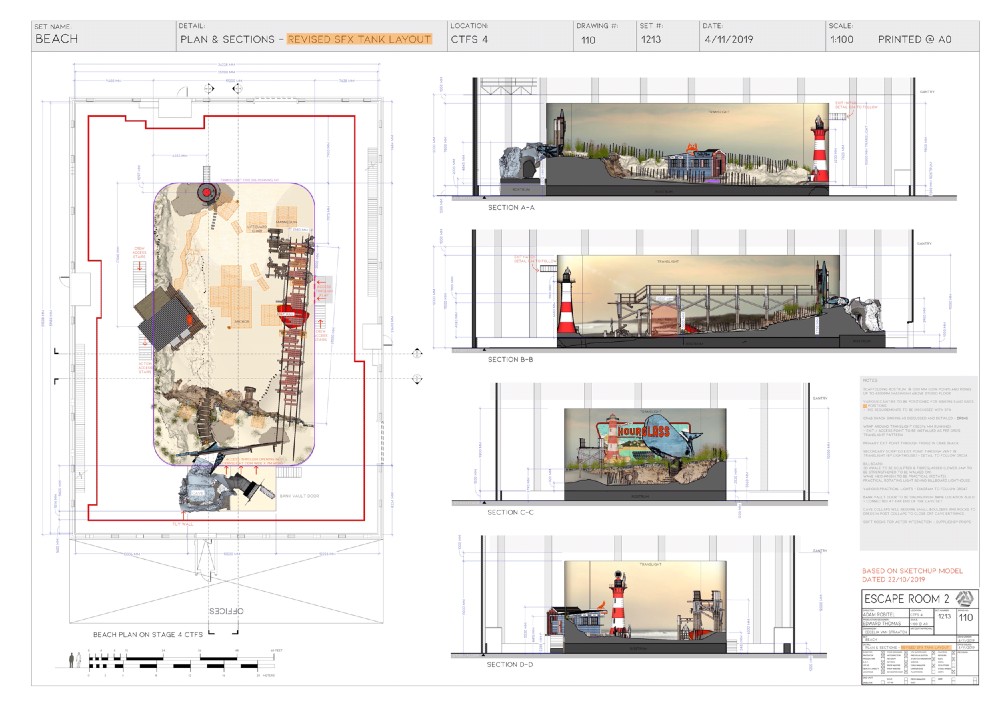
BTL: In that case, the water was also practical and on set?
Thomas: Yeah. Again, you know very little CG in that apart from the melting objects, because making something melt like that, the way it does, is obviously not the easiest task in the world and would take us a lot longer to do then it would the guys with the CG. So we embrace those technologies, because they will make it look better than we ever could. And also, just the shooting time on the day, if we keep waiting around to do those second unit things.
BTL: Are you able to be working on one of the rooms while they’re shooting in another room? Do you have big enough soundstages to be able to continue building while they’re shooting?
Thomas: That was funny, because the majority of the work on both Escape Rooms were done in an old warehouse, it’s called Cotton Mills, and it’s literally a huge old abandoned cotton mill, that has become sort of a studio based in South Africa, I’d actually done three jobs in a row there, so we were ripping out the sets of the Syfy Origin series, while we were starting to build the subway station. It really was an overlap of getting rid of stuff, and then building. Because the set was so big, we needed a proper film studio for that, so we went to the biggest stage at Cape Town Film Studios to create the set, because the spaces at the Cotton Mill weren’t big enough. So we were split over two stages for that, but we had five stages in total. We knew the shooting schedule quite well in advance, we knew the actors’ availability. The great thing about this is that we had the benefit of having the cast all the way through, which is always cool, because then you can jump around and move around, whereas if you have an actor, who’s only coming in for two weeks, you might have to hit all those sets at once. That was beneficial.
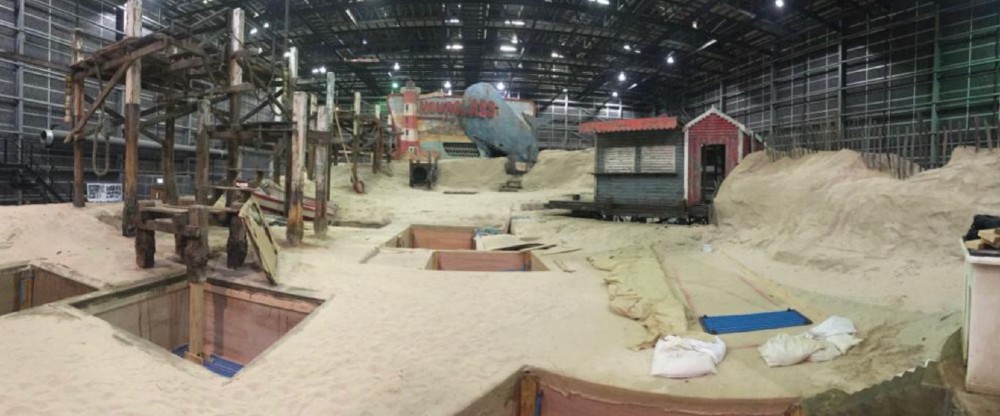
BTL: Do you generally work with stuntmen when designing and building the sets to make sure they’ll be safe for the actors? Do you have time beforehand to work with them and go through those things?
Thomas: Stunts and special effects are massively important, and, of course, they work together, in tandem. We were blessed to have a great South African stunt team and special effects team down there, whom I’d done a lot of work with in the past. From day one, you know what the actors have to do so you recreate sections of the sets for them, to then rehearse the stance on and whether it be wire jerks, or whether it be jumping down holes, or the way that the taxi seat opens up and swallows Taylor. All those things take time and rehearsal. Getting the sets ready on a normal movie, you might get the sets ready a couple of days before, but on these sorts of movies, you have to get those sets ready a couple of weeks before, because lighting tests, the stunt guys need to get in there to rehearse on the set. And they’re dangerous, they are dangerous. In the case of the library in the first movie, that wall really did move, and the actors and the stunt people really were in there. It’s on dead stops and things, but it’s still hazardous stuff. Of course, our number one priority is safety, and as much as you want things to look beautiful, they have to be safe.
BTL: It’s been absolutely great talking to you, and you’ve got me really interested in going down to South Africa. I’ve never been there, but I’ve also never been to Wales, and I hope to go there next year.
Thomas: Wales is busy. It’s become sort of a hub for drama. At the moment, Lucasfilm is shooting a project there, and there’s His Dark Materials, which is shot by a company Bad Wolf. Obviously, Doctor Who — I think there’s about ten fairly major productions happening in Wales at the moment.
BTL: I know Game of Thrones had been shooting there for a while.
Thomas: Yeah, and in Northern Ireland, of course. But South Africa’s a really interesting place, I mean, A. Because of its giant locations, and a selection, you can do an awful lot there. But also of course, the cost base is good. But because so many films go down and Sony has sent a huge amount of projects there, it’s built up this core crew base of technicians that are world class. I can’t praise them enough. I love working there.
Escape Room: Tournament of Champions is currently playing in theaters nationwide.
All pictures courtesy Sony and Mr. Thomas. Click on images for larger versions.





